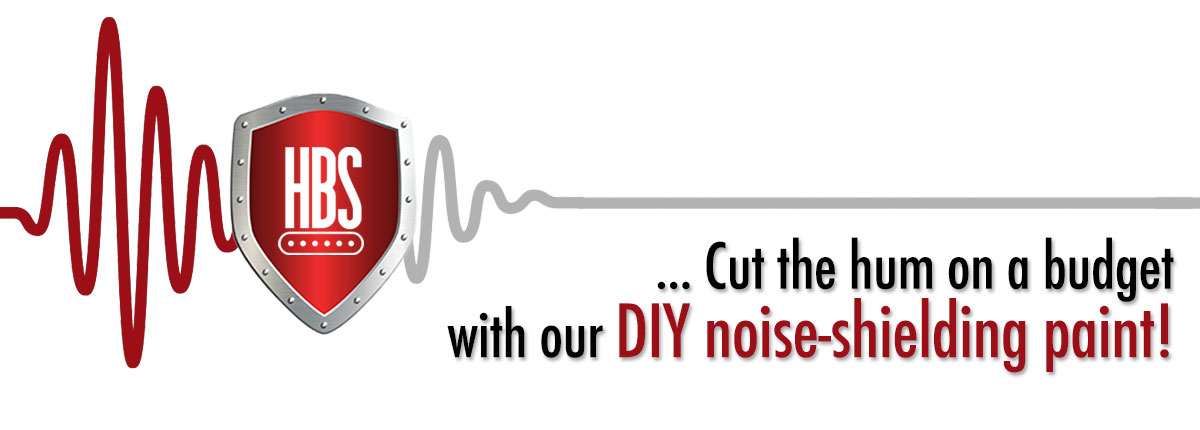
By Ed Malaker
Posted 10/23/2020
If you’re looking to shield your guitar from radio frequency interference and reduce the amount of hiss in your signal, here’s an inexpensive way to make DIY guitar shielding paint that looks great and gets the job done. There are many brands of pre-made shielding paint available, as well as several metal tapes that work just as well.
What is a Shield?
Have you ever noticed that most electronics are inside metal boxes? Audio equipment, especially, is always housed inside a metal box. It’s reasonable to assume that it’s for durability. To some extent, it might be, but the actual reason is that the metal box acts as a shield that protects the electronics inside from interference caused by RF radiation. When using a metal box as a shield, you must connect it to the Ground of your electronics, for it to become a shield. When you do this, incoming radiation will be trapped by the box and shuttled off to Ground before it can reach the audio signal contained within.
The idea is similar to a Faraday cage, and it’s an effective way to reduce the amount of interference in your signal. Many places use a similar concept to block cell phone use inside buildings.
How Does Shielding Apply to the Guitar?
There is no metal box around our guitar electronics, and therefore, they are susceptible to RF and other types of radiation that can enter your signal and degrade it. What we are doing here is using conductive paint to coat our electronics cavities and cavity covers to get as much of our electronics as possible contained within the shield. The conductive paint will work the same way as a metal box, capturing interference, shuttling it to Ground before it can penetrate into your signal, thereby reducing the hiss.
Disclaimer
Shielding is only going to reduce the static present, and it will be unable to eliminate it. Guitar players who use humbuckers may not notice much change, as they are already excellent at reducing hiss caused by interference. Players who use single-coil pickups will notice a more significant difference, but there will still be noise present in the signal. The reason for the noise is that the pickups are still exposed, and they are just as good at picking up interference as they are at string vibrations. In fact, if you look inside an old AM radio, you’ll see the antennae looks very much like a tiny pickup.
Every little bit helps when reducing noise, especially if you use the guitar in a recording studio or for live performance, where there are a lot of variables that can make the guitar pick up extra frequencies.
DIY Guitar Shielding Paint Ingredients
You need two main ingredients for DIY guitar shielding paint: a base and conductive powder.
Conductive Powder
Conductive powder is just what it sounds like it is, and the most popular one is graphite, but you can also use powdered copper, aluminum, silver, nickel, and even gold. We don’t really recommend silver or gold, but graphite, copper, and aluminum are all great choices as conductive powders.
Base
The base is what you are going to use to hold the conductive powder in place. Just like the conductive powders, there are several items you can use. Polyurethane is a great choice, as is shellac. However, we like ordinary acrylic craft paint the best. Acrylic craft paint is easy to work with and doesn’t chip off.
Mix
You want to add the conductive powder to your base until it’s still spreadable but is very sandy and thick. You may want to experiment on a spare board to see how easily it goes on, adding more powder as you go along.
If you have a multimeter, let some test strips dry and test them for conductivity by setting the multimeter to test for resistance and putting one test lead at each end of the strip. If you get a reading, there is enough powder in the base. Adding more can increase conductivity but make it harder to spread.
Use
Use your mixture to apply a thick coat to all cavity walls as well as the inside of covers—the more complete the box, the more interference you will block. You need to attach a wire by screw or solder from the paint to the back of the volume pot or other Ground. If it works out that there are multiple sections or boxes, you will need to connect them with a wire.
- TIP – Remember that all paint needs to connect to Ground to shuttle away the interference.
- TIP – Make an almost free DIY guitar shielding paint using crushed pencils leads and Elmers glue.
Summary
DIY guitar shielding paint is a great way to protect your guitar from interference. I always recommend copper shielding tape for shielding because of its no-brainer application and high conductivity. Still, on many of my guitars, I prefer the matte black finish this approach provides. I also feel that it’s superior to many of the commercial brands, which only offer small amounts of a watered-down product that chips and flakes off.
We hope that you have enjoyed this in-depth look at shielding and have learned something new. If you found it helpful, please feel free to share this guide on Facebook and Twitter. For more articles on guitar electronics, visit humbuckersoup.com.
